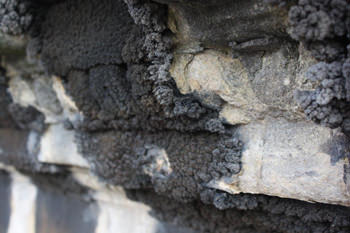Problems of Carbon Sulphation - Cleaning Properly Not Just Done Purely for Aesthetic Reasons

It is sometimes thought that masonry cleaning is done purely for aesthetic reasons, a misunderstanding that's not just made by members of the general public…
Calcium carbonate is the principal constituent of limestone, and is common to mortar and other building masonry. Acidic sulphurous gases, released by the combustion of coal and other fossil fuel, expose the carbonate to chemical reaction. The resulting calcium sulphate and carbon particulates bind to sheltered areas of the affected masonry. 'Carbon Sulphation' may accumulate from a thickness of a few microns to a 'clinker' of several centimetres, as can be seen in the picture (pre-application of poultice).
This type of deposit, if left entirely untouched, can be very damaging to a substrate, leaving it unable to 'breathe', which often results in damaged areas and regions of 'spalling' and/or 'blown' stone surface. The use of an 'Ammonium Carbonate' poultice, mixed from 'poultice components' that we supply, can be particularly useful in these types of situations, when used by professionals. The 'raw components' are mixed together and then water is added, before applying the 'poultice' to the surface and allowing a limited period of dwell, upon the carbon sulphation deposits. After removal, the surface can be effectively rinsed using the ThermaTech superheated water system. Another considerable benefit of using these types of materials, are that they are normally supplied 'dry', saving weight transport costs of a water component.
For more information and further detailed, technical guidance, please contact us